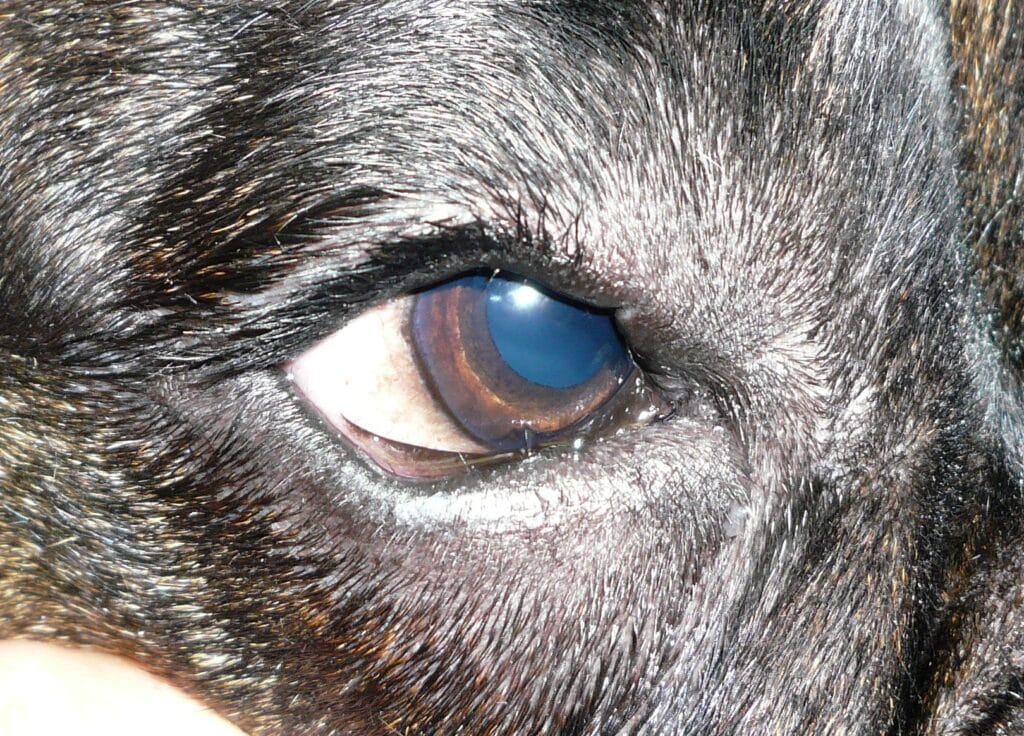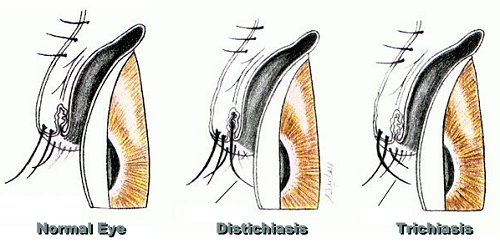- Dog Eye Hair Problems: Solutions for Distichiasis, Ectopic Cilia and Trichiasis
- Distichiasis: Double eyelashes
- Ectopic cilia: Painful cilia in the conjunctiva
- Trichiasis: mal-growing eyelashes
- Prevention of dog eye hair problems
- Possible Complications of Dog Eye Hair Problems
- Frequently affected dog breeds
- Long-term effects of dog eye hair problems
- Important points about dog eye care
- Frequently asked questions about dog eye hair problems:
- Nutrition and eye health in dogs
- Summary
Dog Eye Hair Problems: Solutions for Distichiasis, Ectopic Cilia and Trichiasis
Our dogs' eyes are of great importance to us as pet owners. They give us information about the emotional state and well-being of our four-legged friends. But sometimes hair makes life difficult for our dogs' eyes. In this article, we will discuss the different types of hair problems such as distichiasis, ectopic cilia and trichiasis and how to treat these problems.
Distichiasis: Double eyelashes
Distichiasis is a condition in which the eyelashes grow incorrectly on the edge of the eyelid, resulting in a double lash line. This problem is more common in dogs than other animal species.
Symptoms and diagnosis
Affected dogs often show irritation, increased tear formation or even purulent secretions in the eyes. In order to recognize the misaligned eyelashes, a magnifying glass is required.
Treatment options
One way to treat distichiasis is to manually remove the falsely growing eyelashes using tweezers. However, since the eyelashes usually grow back within a few weeks, permanent removal is required by destroying the hair follicles using heat or cold technology.

(C) By Joel Mills - Own work, CC BY-SA 4.0, https://commons.wikimedia.org/w/index.php?curid=3438089
Ectopic cilia: Painful cilia in the conjunctiva
Ectopic cilia are misaligned eyelashes that grow out of the conjunctiva on the back of the eyelid and constantly scratch the cornea. This leads to repeated injuries to the cornea in the same area.
Symptoms and diagnosis
Dogs with ectopic cilia often suffer from painful, watery eyes. In order to identify misaligned eyelashes, an examination of the inside of the eyelid using a slit lamp is necessary.
Treatment options
As with distichiasis, ectopic cilia can be removed manually, but they also grow back. The best method to permanently eliminate these eyelashes is to surgically remove the entire hair base under general anesthesia.

(C) https://www.eyecareforanimals.com/conditions/distichiasis-trichiasis-and-ectopic-cilia/
Trichiasis: mal-growing eyelashes
Trichiasis is a condition in which normal hair or eyelashes cause corneal irritation due to extreme growth or misalignment of the eyelids.
Symptoms and diagnosis
Dogs with trichiasis exhibit symptoms similar to those of distichiasis and ectopic cilia, including irritation, increased tear production, and corneal injury.
Treatment options
Treatment for trichiasis depends on the underlying cause. Here are some common types of trichiasis and their treatment methods:
- Entropion : In this condition, the entire eyelid or part of the eyelid rolls inward, causing the normal hairs of the skin to rub against the cornea. Surgical removal of a crescent-shaped flap of skin and subsequent suturing to gather the tissue is required to correct the problem.
- Carunculus trichiasis : This is an extreme growth of hair that originates from a small nodule of tissue in the corner of the nose of the eye. These hairs are constantly on the cornea and move in the tear film. For treatment, the affected hair can be removed or the tissue can be surgically corrected.
- Cockertrichiasis : In older cocker spaniels, tissue laxity causes the upper eyelids to droop and curl, causing the long eyelashes to rub on the cornea. A special operation to tighten the upper eyelids is required so that the dogs can see again without pain.
Prevention of dog eye hair problems
To prevent dog eye hair problems and maintain your dog's eye health, you should follow some basic care and preventive measures:
Regular grooming
Regular brushing and trimming of the coat, especially around the eyes, is important to keep hair from getting into the eyes and causing irritation or injury. Make sure the coat is clean and dry, and carefully remove tear stains to reduce the risk of infection.
Eye hygiene
Cleaning your dog's eyes regularly will help remove dirt, tears, and other debris that can cause irritation or promote the growth of bacteria. Use a soft, damp cloth or cotton ball to gently clean your dog's eyes from the inside out. Always use separate wipes or cotton balls for each eye to prevent possible transmission of infections.
Regular vet visits
Schedule regular veterinary visits to check your dog's eye health and detect possible dog eye hair problems early. Your veterinarian can perform a thorough examination and recommend further diagnostic and treatment steps if necessary.
Observing your dog's behavior
Watch for signs of discomfort or pain in your dog, such as frequent blinking, eye rubbing, increased tearing, or redness. These can indicate hair problems in the dog's eyes or other eye diseases. If in doubt, seek the advice of your veterinarian.
Possible Complications of Dog Eye Hair Problems
Untreated dog eye hair problems can lead to various complications that can affect your dog's vision and cause long-term damage. This includes:
- Corneal ulcers : Corneal ulcers are open sores on the cornea that can result from repeated irritation and trauma from hair. Corneal ulcers can cause pain, redness, and tearing and require immediate veterinary attention to prevent infection and further damage.
- Inflammation and infection : Irritation from hair in a dog's eye can lead to inflammation and infection, which can affect your dog's vision and cause long-term damage. Early treatment from a veterinarian is crucial to prevent complications and promote healing.
- Blepharitis : This is an inflammation of the eyelids that can be caused by hair problems in a dog's eye. Blepharitis can cause swelling, redness, itching and pain and requires appropriate treatment to prevent further complications.
- Trichiasis : Untreated hair problems can lead to trichiasis, a condition in which the eyelashes grow inward and constantly rub against the cornea. Trichiasis can cause pain, inflammation, and corneal injury and may require surgical correction.
Frequently affected dog breeds
Although dog eye hair problems can occur in all breeds, some breeds are more affected than others. This includes:
- Shi Tzus
- Lhasa Apsos
- Cocker spaniels
- Pekingese
- poodle
- Yorkshire Terriers
With these breeds it is particularly important to pay attention to possible signs of hair problems in the eyes and to have regular check-ups at the vet.
Long-term effects of dog eye hair problems
Untreated dog eye hair problems can lead to long-term damage and vision impairment. In severe cases, blindness can even occur. Corneal injuries caused by hair can lead to scarring, which can permanently impair vision. Therefore, it is essential to consult a veterinarian immediately if you notice any signs of eye problems.
Important points about dog eye care
Good eye care is crucial to preventing or minimizing dog eye hair problems. Here are some tips for keeping your dog's eyes healthy:
- Regular cleaning : Keep your dog's eye area clean by wiping it regularly with a damp, soft cloth. Be careful not to use soap or harsh cleaning products that could irritate the eyes.
- Trim hair : Keep the hair around your dog's eyes short to prevent it from getting into the eyes and causing irritation or infection.
- Eye exams : Perform simple eye exams regularly to ensure your dog's eyes are clear, moist, and free of inflammation or irritation. Also look out for signs of hair problems such as distichiasis, ectopic cilia or trichiasis.
- Vet Visits : Schedule regular vet visits to monitor your dog's overall eye health and detect and treat possible hair problems early.
- Avoid drafts : Do not expose your dog to strong winds or drafts as this can cause dryness and irritation to the eyes.
By following these tips and caring for your dog's eyes carefully, you can help prevent dog eye hair problems and maintain your four-legged friend's eye health.
Frequently asked questions about dog eye hair problems:
What are the most common dog eye hair problems?
The most common dog eye hair problems are distichiasis, ectopic cilia, and trichiasis. Distichiasis is characterized by a double lash line, ectopic cilia are errant eyelashes that protrude from the conjunctiva of the posterior surface of the eyelid, and trichiasis involves normal hair or eyelashes that cause corneal irritation due to extreme growth or misalignment of the eyelids.
How can I tell if my dog has eye hair problems?
Watch for signs of discomfort or pain in your dog, such as increased blinking, squinting, tears, mucous or pus formation, redness, or swelling. If you notice any of these symptoms, it is advisable to consult a veterinarian for an accurate diagnosis and appropriate treatment.
What are the possible treatments for dog eye hair problems?
Treatment methods depend on the type of hair problem. In distichiasis, the eyelashes can be removed manually or the hair follicles can be destroyed. In the case of ectopic cilia, the eyelashes can also be removed manually or removed surgically. Trichiasis requires surgical correction or removal of a skin flap to improve eyelid position.
How can I prevent dog eye hair problems?
Regular grooming is important to prevent hair problems in the dog's eyes. Make sure the fur around the eyes is clean and free of mats. Regular eye hygiene, such as removing debris and tear stone, can also help. Vet visits for routine eye health checks are also important to identify and treat problems early.
Nutrition and eye health in dogs
A balanced diet is important not only for your dog's overall health, but also for their eye health. A diet rich in vitamins, minerals and antioxidants can help reduce the risk of eye problems. Some important nutrients for eye health in dogs include:
- Vitamin A : This vitamin is important for eye health and vision. It is found in foods such as liver, carrots, sweet potatoes and green leafy vegetables.
- Vitamin C : As an antioxidant, vitamin C supports eye health and protects cells from damage caused by free radicals. Good sources of vitamin C include citrus fruits, berries, peppers and broccoli.
- Vitamin E : Vitamin E is another antioxidant that promotes eye health. It is found in nuts, seeds, vegetable oils and green leafy vegetables.
- Lutein and Zeaxanthin : These two carotenoids are important for eye health and vision. They are found in green leafy vegetables, peppers, pumpkin and egg yolks.
- Omega-3 fatty acids : Omega-3 fatty acids support eye health and can help reduce inflammation. Good sources of omega-3 fatty acids include fatty fish such as salmon, mackerel and sardines, as well as flaxseeds, walnuts and chia seeds.
Be sure to provide your dog with a balanced diet that contains all the necessary nutrients to promote eye health and prevent dog eye hair problems.
Summary
Dog eye hair problems, such as distichiasis, ectopic cilia and trichiasis, can cause significant discomfort and long-term damage if not recognized and treated in a timely manner. By taking your dog's eye care seriously, scheduling regular vet visits, and maintaining a balanced diet, you can help maintain your dog's eye health and prevent or minimize dog eye hair problems.
Remember that each breed has different needs and risk factors. For breeds with a higher risk of dog eye hair problems, it is particularly important to pay attention to possible signs and take appropriate measures in a timely manner. Your dog's health and well-being are in your hands, and good eye care is an important part of caring for your four-legged friend.
